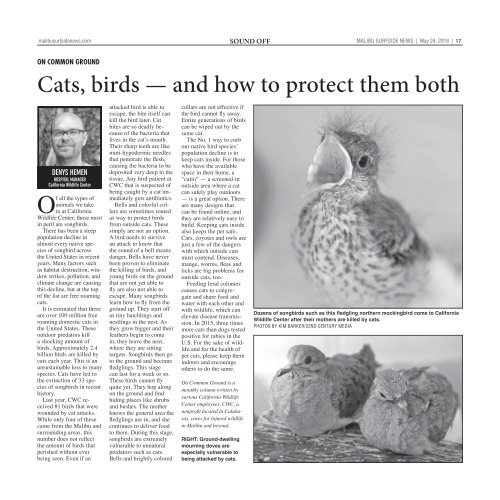MSN_052418
Create successful ePaper yourself
Turn your PDF publications into a flip-book with our unique Google optimized e-Paper software.
malibusurfsidenews.com Sound Off<br />
Malibu surfside news | May 24, 2018 | 17<br />
On Common Ground<br />
Cats, birds — and how to protect them both<br />
Denys Hemen<br />
Hospital Manager<br />
California Wildlife Center<br />
Of all the types of<br />
animals we take<br />
in at California<br />
Wildlife Center, those most<br />
in peril are songbirds.<br />
There has been a steep<br />
population decline in<br />
almost every native species<br />
of songbird across<br />
the United States in recent<br />
years. Many factors such<br />
as habitat destruction, window<br />
strikes, pollution, and<br />
climate change are causing<br />
this decline, but at the top<br />
of the list are free roaming<br />
cats.<br />
It is estimated that there<br />
are over 100 million free<br />
roaming domestic cats in<br />
the United States. These<br />
outdoor predators kill<br />
a shocking amount of<br />
birds. Approximately 2.4<br />
billion birds are killed by<br />
cats each year. This is an<br />
unsustainable loss to many<br />
species. Cats have led to<br />
the extinction of 33 species<br />
of songbirds in recent<br />
history.<br />
Last year, CWC received<br />
81 birds that were<br />
wounded by cat attacks.<br />
While only four of these<br />
came from the Malibu and<br />
surrounding areas, this<br />
number does not reflect<br />
the amount of birds that<br />
perished without ever<br />
being seen. Even if an<br />
attacked bird is able to<br />
escape, the bite itself can<br />
kill the bird later. Cat<br />
bites are so deadly because<br />
of the bacteria that<br />
lives in the cat’s mouth.<br />
Their sharp teeth are like<br />
mini-hypodermic needles<br />
that penetrate the flesh,<br />
causing the bacteria to be<br />
deposited very deep in the<br />
tissue. Any bird patient at<br />
CWC that is suspected of<br />
being caught by a cat immediately<br />
gets antibiotics.<br />
Bells and colorful collars<br />
are sometimes touted<br />
as way to protect birds<br />
from outside cats. These<br />
simply are not an option.<br />
A bird needs to survive<br />
an attack to know that<br />
the sound of a bell means<br />
danger. Bells have never<br />
been proven to eliminate<br />
the killing of birds, and<br />
young birds on the ground<br />
that are not yet able to<br />
fly are also not able to<br />
escape. Many songbirds<br />
learn how to fly from the<br />
ground up. They start off<br />
as tiny hatchlings and<br />
nestlings in the nest. As<br />
they grow bigger and their<br />
feathers begin to come<br />
in, they leave the nest,<br />
where they are sitting<br />
targets. Songbirds then go<br />
to the ground and become<br />
fledglings. This stage<br />
can last for a week or so.<br />
These birds cannot fly<br />
quite yet. They hop along<br />
on the ground and find<br />
hiding places like shrubs<br />
and bushes. The mother<br />
knows the general area the<br />
fledglings are in, and she<br />
continues to deliver food<br />
to them. During this stage,<br />
songbirds are extremely<br />
vulnerable to unnatural<br />
predators such as cats.<br />
Bells and brightly colored<br />
collars are not effective if<br />
the bird cannot fly away.<br />
Entire generations of birds<br />
can be wiped out by the<br />
same cat.<br />
The No. 1 way to curb<br />
our native bird species’<br />
population decline is to<br />
keep cats inside. For those<br />
who have the available<br />
space in their home, a<br />
“catio” — a screened-in<br />
outside area where a cat<br />
can safely play outdoors<br />
— is a great option. There<br />
are many designs that<br />
can be found online, and<br />
they are relatively easy to<br />
build. Keeping cats inside<br />
also keeps the pet safe.<br />
Cars, coyotes and owls are<br />
just a few of the dangers<br />
with which outside cats<br />
must contend. Diseases,<br />
mange, worms, fleas and<br />
ticks are big problems for<br />
outside cats, too.<br />
Feeding feral colonies<br />
causes cats to congregate<br />
and share food and<br />
water with each other and<br />
with wildlife, which can<br />
elevate disease transmission.<br />
In 2015, three times<br />
more cats than dogs tested<br />
positive for rabies in the<br />
U.S. For the sake of wildlife<br />
and for the health of<br />
pet cats, please keep them<br />
indoors and encourage<br />
others to do the same.<br />
On Common Ground is a<br />
monthly column written by<br />
various California Wildlife<br />
Center employees. CWC, a<br />
nonprofit located in Calabasas,<br />
cares for injured wildlife<br />
in Malibu and beyond.<br />
RIGHT: Ground-dwelling<br />
mourning doves are<br />
especially vulnerable to<br />
being attacked by cats.<br />
Dozens of songbirds such as this fledgling northern mockingbird come to California<br />
Wildlife Center after their mothers are killed by cats.<br />
Photos by Kim Barker/22nd Century Media


















